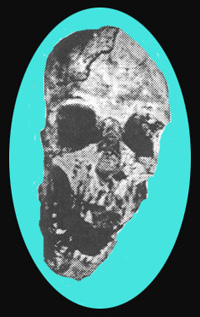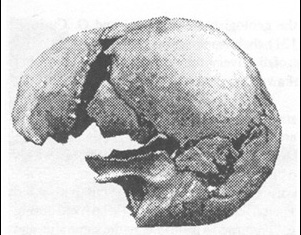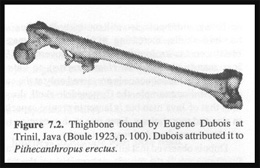Ancient Skulls and Bones
 |
Reck's Skeleton The
first significant African discovery related to human origins occurred
in 1913 when Professor Hans Reck, of Berlin University, found a human
skeleton in the upper part of Bed II at Olduvai Gorge, Tanzania. Modern
dating methods give a late Early Pleistocene date of around 1.15 million
years for this site. Reck said, "The bed in which the human remains
were found....showed no sign of disturbance." The skeleton was distorted by compression from the weight of substantial accumulation of sediment in the overlying strata. W. O. Dietrich, writing in 1933, stated that this feature of the skeleton argued against its being a recent, shallow burial. George Grant MacCurdy, a leading anthropologist from Yale University, considered Reck's discovery to be genuine. [pp. 630-631, Forbidden Archeology] |
|
Fig. 6.4 Castenedolo Skull This anatomically modern human skull (Sergi 1884, plate 1) was found in 1880 at Castenedolo, Italy. The stratum from which it was taken is assigned to the Astian stage of the Pliocene (Oakley 1980, p. 46). According to modern authorities (Harland et al, 1982, p. 110), the Astian belongs to the Middle Pliocene, wihch would give the skull an age of 3-4 million years. [p. 424, Forbidden Archeology] |
 |
 |
Javaman Thighbone In August 1892, Eugene Dubois discovered a fossilized humanlike femur on the bank of the Solo River in central Java, near the village of Trinil. 45 feet from this location he found a skullcap and molars. Dubois believed the molars, skull, and femur all came from the same being. However, the fact that these bones were found 45 feet from the place where the skull was unearthed, in a stratum containing hundreds of other animal bones makes doubtful the claim that both the thighbone and the skull actually belonged to the same creature or even the same species. In 1895 Dubois presented his findings to the Berlin Society for Anthropology, Ethnology, and Prehistory.The president of the society, Dr. Virchow declared that the femur was human and the skull belonged to an ape. Late in his life, Dubois concluded that the skullcap belonged to a large gibbon, an ape not considered by evolutionists to be closely related to humans. But this concept of the "missing link" is still widely promoted today! [pp. 464-465, Forbidden Archeology] |
Unlimited Resources/BBT Science Books 2001-2003